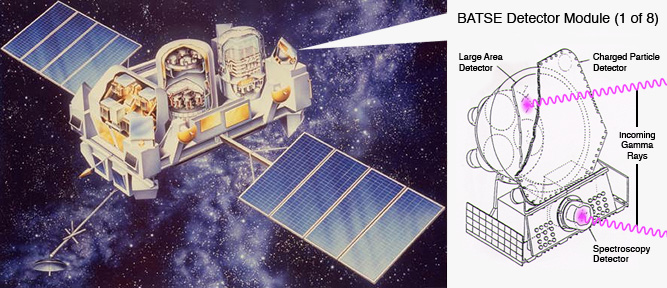In the first few years after the 1973 announcements there were only questions, few answers. How far away were they? What caused them? How often do they happen? The 1991 launch of the Compton Gamma Ray Observatory (CGRO), a satellite observatory dedicated to observing the high-energy Universe, ushered in a new era of GRB observations that gave us some answers.
Beginning with the Burst Alert Telescope (BATSE) aboard Compton we discovered that GRBs happen all across the Universe as intense blasts of fusion energy – the same energy of the H-bomb. BATSE detected a burst a day so we learned that GRBs aren’t rare events, but they are fleeting. Some last only a few hundredths of a second while others last several minutes. It’s hard to catch GRBs in the act, so in order to study them we needed to get a fix on their position in the sky and rapid telemetry for communicating the position to space- and ground-based telescopes. A series of satellite missions followed Compton, each bearing gamma-ray and X-ray detectors and the technologies to communicate real-time burst locations to a network of telescopes poised for follow up observations. In a two-year period discoveries came fast and furious.
Left panel: Compton Gamma Ray Observatory, the second of NASA's Great Observatories. Right panel: Diagram of the BATSE detector module, part of the Burst and Transient Source Experiment (BATSE), on Compton.: The BATSE detector module identified gamma-ray bursts by triggering on increases in the rate of detected gamma rays over the background rate. The illustration on the left is an artist's rendering of the Compton Gamma Ray Observatory indicating the location of the BATSE detectors on the observatory. The diagram on the right shows one of the eight detectors.
Credit: NASA


